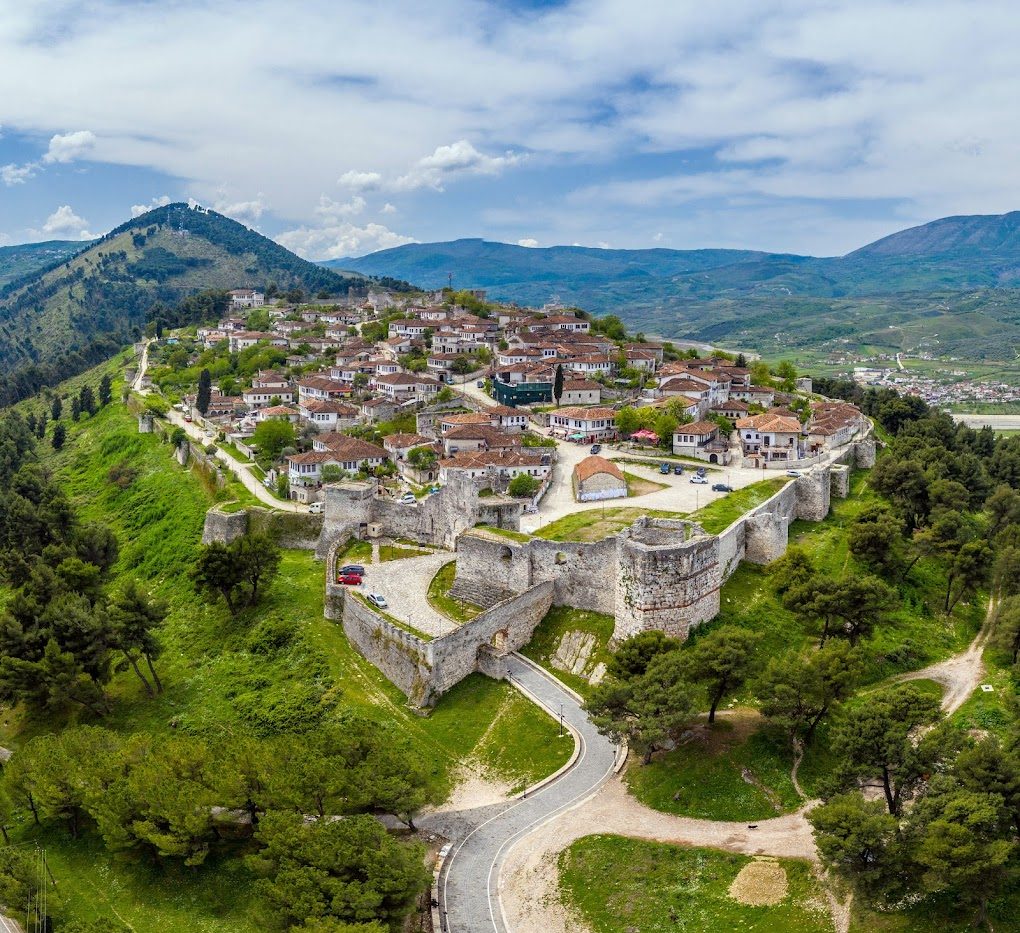
Key Takeaways
- Berat Castle is a UNESCO World Heritage site that showcases centuries of Albanian history and architecture.
- It features a diverse array of structures, including Byzantine churches, Ottoman mosques, and residential quarters.
- The fortress offers stunning panoramic views of Berat and the Osumi River gorge.
- Its strategic importance is reflected through its impressive defensive features and layered history.
- Visitors can explore museums, religious sites, and traditional homes, making it a comprehensive cultural experience.
Table of contents
Perched on a rugged hill, Berat Castle, or Kalaja e Beratit, stands as a testament to Albania’s rich history and resilience. Its ancient walls have witnessed centuries of change, bearing silent witness to diverse civilizations that shaped the region.
From its Illyrian origins to Byzantine, Ottoman, and modern influences, Berat Castle embodies a layered narrative of cultural synthesis. Whether you’re a history enthusiast or a curious traveler, exploring this fortress is an immersive journey into Albania’s soul.
Historical Background of Berat Castle
Origins and Timeline of Construction
Originally established during the Illyrian period, Berat Castle’s roots trace back to the 4th century BC. Over the centuries, it evolved into a formidable fortress through successive phases of construction. During the 6th century AD, Emperor Justinian I reinforced the structure, adding resilient walls and towers to withstand sieges.
Later, the castle was shaped by local feudal powers, notably the Muzaka family, who fortified it further and transformed it into a regional stronghold.
Role Through Different Historical Periods
Throughout the Byzantine era, Berat Castle served as a strategic military outpost, guarding against Slavic invasions and housing numerous churches that underscored its religious significance. When the Ottoman Empire took control in the 15th century, the castle underwent modifications—adding mosques like the Red Mosque and White Mosque. Such alterations reflect the socio-cultural shift and religious diversity of the period.
Important Historical Events
The Congress of Berat in 1444, held nearby, was pivotal for Albanian resistance against Ottoman expansion. Although not inside the castle, this assembly symbolizes Berat’s central role in shaping Albanian history. Its walls have endured sieges and conflicts, standing as a testimony to the resilience of its inhabitants.
Architectural Features and Layout of Berat Castle
Description of Structure and Key Elements
The fortress spans over a kilometer of rugged terrain, featuring robust stone walls punctuated by watchtowers. Its strategic location provides commanding views of Berat’s rooftops and the surrounding landscape. Walking through its gates, visitors encounter a labyrinth of narrow streets, ancient churches, and quaint residences.
Defense Features & Building Materials
The defensive architecture combines large stone blocks crafted from locally sourced materials, forming resilient walls capable of withstanding sieges. Towers situated at key points provided surveillance and defense. The castle also features cisterns carved into rock—an essential resource during prolonged defense efforts.
Notable Buildings within the Castle
- Churches: The Church of the Holy Trinity and St. Mary of Blachernae house stunning frescoes and icons, exemplifying Byzantine art.
- Mosques: The Ottoman-era Red Mosque and White Mosque reflect Islamic architectural influences.
- Onufri Museum: Located inside the Church of the Dormition, it features priceless icons by Onufri, a famed 16th-century Albanian painter.
- Residential Quarter: Still inhabited today, this area preserves traditional Albanian architecture and way of life, with cobbled streets and authentic homes.
Cultural and Heritage Importance
UNESCO World Heritage Designation
In 2008, Berat Castle gained UNESCO recognition as part of the “Historic Centres of Berat and Gjirokastra”. This honor acknowledges its extraordinary preservation of Ottoman urban layout and Byzantine architecture, and emphasizes its global cultural significance.
Significance to Albanian Heritage
Berat Castle embodies Albanian resilience and cultural diversity. Its layered history—spanning Illyrian, Roman, Byzantine, and Ottoman periods—mirrors the nation’s journey toward unity and identity. It serves as a living monument reinforcing national pride and cultural continuity.
Legends & Folklore
Surrounding Berat Castle are stories of hidden tunnels and buried treasures, fueling local legend. Tales speak of heroic defenders who fought valiantly and secret passages that conceal centuries of mysteries. These stories enhance the castle’s mystique, captivating visitors and adding to its legendary aura.
Exploring Berat Castle Today
Visitor Expectations
Exploring Berat Castle involves navigating uneven terrain, so comfortable, sturdy footwear is recommended. Be prepared to spend several hours uncovering its secrets—each corner reveals another fragment of Albania’s vibrant history. The panoramic views and historical sites offer a rewarding experience for all visitors.
Highlights of the Castle Grounds
- Panoramic Viewpoints: Capture breathtaking vistas of Berat, the Osumi River gorge, and surrounding mountains—perfect for photos and reflection.
- Onufri Museum: Admire exquisite Byzantine icons by Onufri inside the church, a highlight for art lovers.
- Religious Sites: Discover the Byzantine churches and Ottoman mosques that illustrate the region’s spiritual diversity.
- Residential Area: Wander through the preserved traditional neighborhood, immersing in local architecture and lifestyle.
Practical Information for Tourists
Operational hours vary seasonally; check official websites before your visit. Entrance fees are modest, with additional costs for museums and specific sites. Guided tours are highly recommended to enrich your understanding, available in multiple languages.
Berat Castle in the Context of Albania
Location Within Berat
Sitting atop a rocky hill, Berat Castle dominates the city’s skyline and acts as its historical centerpiece. Its vantage point offers commanding views across the city and river valley, making it a vital part of Berat’s cultural identity.
Broader Context in Albania
As part of Albania’s rich heritage, Berat Castle attracts visitors alongside other historic sites like Gjirokastra and Butrint. It plays a crucial role in the country’s tourism development, offering a tangible link to Albania’s multicultural past.
Recommendations for Combined Visits
To deepen your experience, combine your castle exploration with visits to the Ethnographic Museum or a stroll along the scenic Osumi River. These additional experiences provide context and a richer understanding of Berat’s living heritage.
Conclusion
Berat Castle stands as a vibrant symbol of Albania’s enduring history and cultural diversity. Its walls, churches, mosques, and stories invite travelers to step into a living museum—one that seamlessly blends past and present. If you seek a destination where history, architecture, and scenic beauty converge, Berat Castle is undeniably a must-visit.


0 Comment